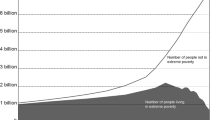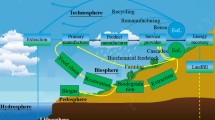Abstract
The strategy of carbon neutrality is resha** the global landscape of resource flow and recycling. As the final sink of geological minerals, the proliferated anthropogenic minerals, also called secondary resources, play an increasingly important role in resource supply enrichment. Niobium is a critical metal that lacks full concern for its sustainability. The fundamental principle of niobium circularity is to recycle and maintain the material as close to the manufacturing process as possible. Here we estimate the niobium-containing applications lost at their end-of-life, underscoring the imperative to minimize such disposal. Additionally, we elucidate the extraction processes for scrap and alloy quantities throughout the industry’s lifecycle. Drawing from anticipated waste generated by the majority of niobium applications, a forecast indicates a potential loss of approximately 168 kt by 2090 in the absence of recycling. Contrastingly, with a recycling efficiency of 90% for niobium, the projected loss diminishes to approximately 16 kt. We delve into the significance of niobium’s circular economy and explore various aspects that demand further investigation for a seamless transition from linear to circular practices.
Similar content being viewed by others
References
Alves A R, Coutinho A d R. 2015. The evolution of the niobium production in Brazil. Mat Res, 18: 106–112
Alves A R, Coutinho A d R. 2019. Life cycle assessment of niobium: A mining and production case study in Brazil. Miner Eng, 132: 275–283
Bakry M, Li J, Zeng X. 2023. Evaluation of global niobium flow modeling and its market forecasting. Front Energy, 17: 286–293
Broadbent C. 2016. Steel’s recyclability: Demonstrating the benefits of recycling steel to achieve a circular economy. Int J Life Cycle Assess, 21: 1658–1665
Charpentier Poncelet A, Helbig C, Loubet P, Beylot A, Muller S, Villeneuve J, Laratte B, Thorenz A, Tuma A, Sonnemann G. 2022. Losses and lifetimes of metals in the economy. Nat Sustain, 5: 717–726
Ciacci L, Reck B K, Nassar N T, Graedel T E. 2015. Lost by design. Environ Sci Technol, 49: 9443–9451
Ciacci L, Harper E M, Nassar N T, Reck B K, Graedel T E. 2016. Metal dissipation and inefficient recycling intensify climate forcing. Environ Sci Technol, 50: 11394–11402
Cullen J M, Allwood J M, Bambach M D. 2012. Map** the global flow of steel: From steelmaking to end-use goods. Environ Sci Technol, 46: 13048–13055
European C, Directorate-General for Internal Market I E, Smes, Bobba S, Carrara S, Huisman J, Mathieux F, Pavel C. 2020. Critical raw materials for strategic technologies and sectors in the EU—A foresight study (doi/https://doi.org/10.2873/58081): Publications Office
Freiin von Rennenberg T S. 2021. Towards a circular economy of critical raw materials: The case of niobium. Dissertation for Master’s Degree. Twente: University of Twente
Graedel T E, Allwood J, Birat J P, Buchert M, Hagelüken C, Reck B K, Sibley S F, Sonnemann G. 2011. What do we know about metal recycling rates? J Industrial Ecol, 15: 355–366
Graedel T E, Reck B K, Miatto A. 2022. Alloy information helps prioritize material criticality lists. Nat Commun, 13: 150
Hagelüken C, Goldmann D. 2022. Recycling and circular economy—Towards a closed loop for metals in emerging clean technologies. Miner Econ, 35: 539–562
Heisterkamp F, Carneiro T. 2011. Niobium: Future possibilities—Technology and the market place. Niobium, Science and Technology
IRP. 2024. Global Resources Outlook 2024: A report by the International Resource Panel. Nairobi, Kenya: United Nations Environment Programme
Klinkenberg C, Trute S, Bleck W. 2006. Niobium in engineering steels for automotive applications. Steel Res Int, 77: 698–703
Liang Z, Geng Y, Zhong C, **ao S, Wei W. 2024. Tracking the evolution of niobium cycle in China from 2000 to 2021: A dynamic material flow analysis. J Clean Prod, 434: 140455
McCaffrey D M, Nassar N T, Jowitt S M, Padilla A J, Bird L R. 2023. Embedded critical material flow: The case of niobium, the United States, and China. Resour Conserv Recycl, 188: 106698
Milan Grohol, Constanze Veeh. DG GROW, European Commission. 2023. European Commission, Study on the Critical Raw Materials for the EU 2023-Final Report
Mujkic Z, Krekhovetckii N, Kraslawski A. 2019. Material pinch location and critical materials recycling. Int J Manage Sustainability, 8: 10–19
Pan S, Zeng F, Su N, **an Z. 2020. The effect of niobium addition on the microstructure and properties of cast iron used in cylinder head. J Mater Res Tech, 9: 1509–1518
Rahimpour Golroudbary S, Krekhovetckii N, El Wali M, Kraslawski A. 2019. Environmental sustainability of niobium recycling: The case of the automotive industry. Recycling, 4: 5
Sovacool B K, Ali S H, Bazilian M, Radley B, Nemery B, Okatz J, Mulvaney D. 2020. Sustainable minerals and metals for a low-carbon future. Science, 367: 30–33
Sverdrup H U, Olafsdottir A H. 2023. Modelling the dynamics of the industrial vanadium cycle using the WORLD7 Integrated Assessment Model. Resources Environ Sustainability, 13: 100121
Tkaczyk A H, Bartl A, Amato A, Lapkovskis V, Petranikova M. 2018. Sustainability evaluation of essential critical raw materials: Cobalt, niobium, tungsten and rare earth elements. J Phys D-Appl Phys, 51: 203001
Tutton C G, Young S B, Habib K. 2022. Pre-processing of e-waste in Canada: Case of a facility responding to changing material composition. Resources Environ Sustainability, 9: 100069
Wang P, Wang H, Chen W Q, Pauliuk S. 2022. Carbon neutrality needs a circular metal-energy nexus. Fundamental Res, 2: 392–395
Zeng X. 2023. Win-Win: Anthropogenic circularity for metal criticality and carbon neutrality. Front Environ Sci Eng, 17: 23
Zeng X, Ogunseitan O A, Nakamura S, Suh S, Kral U, Li J, Geng Y. 2022a. Resha** global policies for circular economy. Circular Economy, 1: 100003
Zeng X, **ao T, Xu G, Albalghiti E, Shan G, Li J. 2022b. Comparing the costs and benefits ofvirgin and urban mining. J Manage Sci Eng, 7: 98–106
Zhu Y, Syndergaard K, Cooper D R. 2019. Map** the annual flow of steel in the United States. Environ Sci Technol, 53: 11260–11268
Acknowledgements
This study was supported by the National Natural Science Foundation of China (Grant Nos. 92062111 & 72394402).
Author information
Authors and Affiliations
Corresponding author
Ethics declarations
Conflict of interest The authors declare that they have no conflict of interest.
Electronic supplementary material
Rights and permissions
About this article
Cite this article
Zeng, X., Gómez, M., Bakry, M. et al. Anthropogenic mineral generation and its potential resource supply: The case of niobium. Sci. China Earth Sci. (2024). https://doi.org/10.1007/s11430-023-1349-2
Received:
Revised:
Accepted:
Published:
DOI: https://doi.org/10.1007/s11430-023-1349-2




